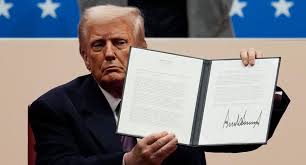
President Donald Trump has signed an executive order mandating the integration of artificial intelligence (AI) education across all U.S. public schools, marking a significant policy shift aimed at future-proofing the American workforce.
This presidential directive calls for the nationwide implementation of K-12 AI curricula, covering critical areas such as machine learning, coding, data science, robotics, and AI ethics. President Trump positions this initiative as essential for safeguarding national security, strengthening economic competitiveness, and ensuring that American students do not fall behind global rivals like China in the race for technological dominance.
“We will make sure American students lead the world in AI innovation, not trail behind China,” President Trump declared, casting the order as a key pillar of his broader technology and economic agenda.
While proponents hail the move as a necessary step to close the widening AI skills gap, critics argue that the executive order lacks a robust funding mechanism and fails to address the deeper societal and ethical implications of widespread AI deployment. Education experts caution that without proper resources, the rollout could exacerbate existing inequities between affluent and under-resourced school districts.
As AI continues to transform critical sectors such as healthcare, finance, defense, and manufacturing, this presidential policy places America’s education system squarely at the forefront of the national discourse on technological readiness. Whether this ambitious mandate will translate into real-world classroom impact—or remain entangled in political and logistical challenges—will shape the trajectory of America's AI leadership for decades to come.
By subscribing, you agree to receive email related to content and products. You unsubscribe at any time.
Copyright 2025, AI Reporter America All rights reserved.